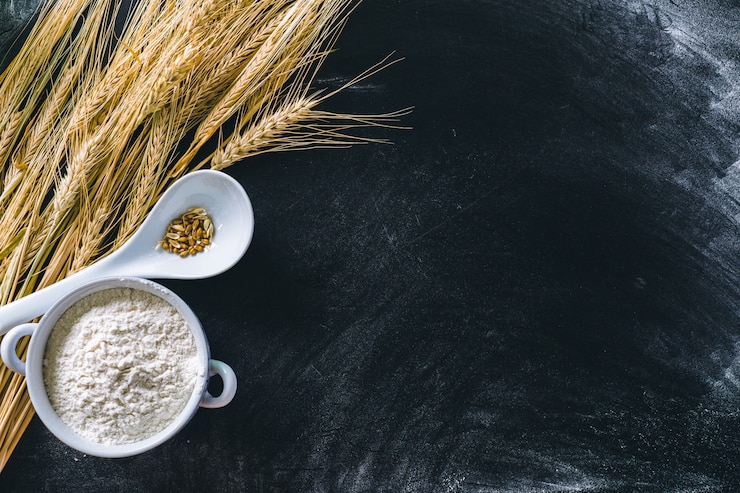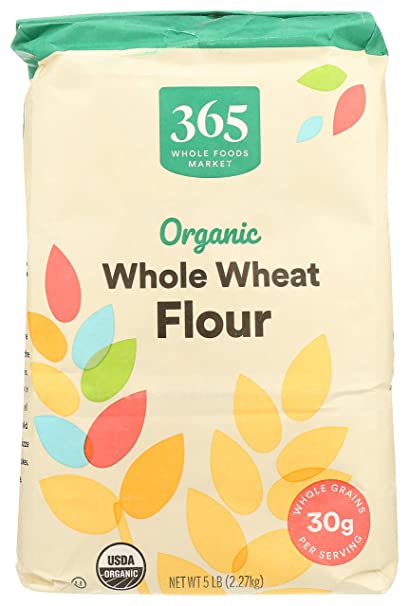Wheat flour is a powder created from grinding wheat consumed by humans. If the gluten content of a wheat variety is low, it is called “soft” or “weak,” and if the gluten amount is high, it is called “hard” or “strong.” Hard flour, often known as bread flour, is vital in gluten, containing 12 to 14 percent gluten, and its dough is elastic and keeps its shape well once baked. Soft flour has a lower gluten content than hard flour, resulting in a more acceptable, crumblier loaf. Cake flour, which contains the least gluten, and pastry flour, slightly more gluten than cake flour, are soft flour.
Wheat is defined by several factors, including the season in which it is grown (spring or winter wheat), its color, whether it is “hard” or “soft,” the quantity of protein it contains, and the amount of a specific protein known as gluten. Hard wheat is often bronze in color and has more gluten than soft wheat, light golden.
Wheat Nutrition Facts
Here is a table of Wheat Flour Nutrition Facts, for a serving size of 100 grams and with percent daily values based on a 2,000-calorie diet:
| Nutrient | Amount Per Serving | % Daily Value |
| Calories | 364 | 18% |
| Total Fat | 1.2 g | 2% |
| Saturated Fat | 0.2 g | 1% |
| Polyunsaturated Fat | 0.4 g | – |
| Monounsaturated Fat | 0.2 g | – |
| Cholesterol | 0 mg | 0% |
| Sodium | 1 mg | 0% |
| Potassium | 118 mg | 3% |
| Total Carbohydrate | 76 g | 25% |
| Dietary Fiber | 2.7 g | 11% |
| Sugars | 0.4 g | – |
| Protein | 10 g | 20% |
| Vitamin D | 0 IU | 0% |
| Calcium | 15 mg | 1% |
| Iron | 4.3 mg | 24% |
| Vitamin B6 | 0.2 mg | 11% |
| Magnesium | 29 mg | 7% |
Note: These values are based on averages and may vary depending on the brand and type of wheat flour.
Is Eating Wheat Flour Good For Your Health?
Wheat flour has a lot of health benefits:
Whole Wheat Flour For Skin And Hair
Wheat flour’s key advantage is that it has a beneficial influence on our bodies. It includes selenium, an antioxidant necessary for the body’s defense against infections. It also prevents dryness and dandruff on the scalp. Whole wheat grain contains zinc and vitamin E, which aids in the growth of glossy hair, nourishes it, and protects it from damage. It also aids in the tightening and anti-aging of the skin.
Aids Digestion
The high fiber content of whole wheat grains has a variety of consequences on our bodies. It not only aids in digestion but also aids in the removal of toxic poisons from the body. Whole wheat grain’s antibacterial qualities aid in reducing the adverse effects on digestive tracts and improving the interstitial health tract. The body’s entire health improves with a healthy digestive tract, and it improves the appearance of the skin and hair.
Prevents Weight Gain
According to studies, consuming high-fiber foods can help with weight loss and reduce the risk of obesity. Whole wheat grain has also been shown in studies to help reduce harmful fat in the body and aid in its distribution. It was predicted that a person’s body mass index (BMI) would be reduced if they ate three meals of whole wheat grain each day.
High In Nutrients And Fibre
Whole wheat flour contains vitamins, fibers, magnesium, zinc, and proteins. The zinc concentration of whole wheat is high, and it also contains a lot of Vitamin B. Minerals such as zinc, iron, magnesium, and manganese are abundant in it. Whole wheat contains antioxidants as well.
Cleanses The System
Because whole wheat atta promotes pure blood and eliminates dangerous bacteria, it is regarded as the most acceptable detox diet. With the ingestion of whole wheat grain, diseases such as headaches, joint discomfort, and bloating can be relieved. Because atta contains fiber, it helps relieve constipation by detoxifying the system and maintaining a healthy colon and bowel.
Reduction In Chronic Inflammation
According to studies, people who choose whole wheat grains over refined grains are less likely to have inflammation. Many chronic diseases are caused by inflammation. Wheat flour has several advantages, one of which is that it decreases inflammation. Including whole wheat in your diet can help reduce inflammation while lowering your risk of chronic diseases.
Improves Mental Health
Whole wheat contains vitamins B and E, which aid in energy production and maintaining healthy DNA in the body. Vitamin B is considered to be made up of eight different types of vitamins. The Vitamin B complex is the most well-known, but our bodies cannot store it because it is water-soluble.
As a result, integrating the Vitamin B complex into our diet is beneficial for brain inflammatory control and subclinical mental disorder. On the other hand, Vitamin E is an excellent source of protection against memory-related disorders.
Lowers The Risk Of Heart Diseases
Reduces the risk of heart disease – The essential health advantage of eating whole grains is that it reduces the risk of heart disease.
Three (28-gram) servings of whole grains each day, according to studies, are beneficial to heart health. Researchers discovered that whole grain diets are better for heart health than processed grains.
Reduces The Risk Of Cancer
According to research, whole-wheat consumption has been linked to a lower risk of skin cancer.
Whole wheat contains selenium, which aids in this process and aids in skin hydration and brightness maintenance—whole wheat benefits from preventing colorectal cancer, a frequent kind of cancer.
Helps In the Regulation Of PMS Symptoms
The inclusion of Vitamin B in whole wheat aids in alleviating PMS symptoms. The magnesium content in whole wheat lowers anxiety and pain associated with PMS symptoms.
Wheat germ chemicals (vitamins B6 and E, calcium, and essential acids) have been shown to have beneficial benefits on PMS symptoms in studies.
Whole Wheat Flour
Features
- Three hundred sixty-five Whole Foods Market products give you that dance-down-the-aisles feeling, virtual aisles too! Our massive range of choices with premium ingredients at prices you can get down with makes grocery shopping s.o much more than tossing the basics in your cart
Is Wheat Flour Better Than Rice?
Rice and wheat are two of the world’s most widely consumed cereal grains. Since prehistoric times, these grains have been the critical ingredient in staple cuisines for many civilizations. The inclusion of Vitamin B in whole wheat aids in alleviating PMS symptoms, and the magnesium content in whole wheat lowers anxiety and pain associated with PMS symptoms.
Wheat germ chemicals (vitamins B6 and E, calcium, and essential acids) have been shown to have beneficial benefits on PMS symptoms in studies. Rice flavor varies depending on various factors, including variety and cooking methods. Both have a moderate to nutty flavor, and wheat can have a harsh taste at times.
Wheat has a more fibrous texture, whereas most rice has a more delicate texture. Rice is frequently boiled and used in cooking, and wheat can be cooked, although usually used to make flour. Wheat flour is used in various dishes, including bread, spaghetti, noodles, pastries, pizza, etc.
Which Flour Is Best For Dieting?
Here are some of the best flour for diting:
Whole Wheat Flour
Jowar, also known as sorghum, is a gluten-free flour high in protein, dietary fiber, calcium, iron, phosphorus, vitamins B, and C, promoting weight loss. Jowar’s nutritional profile aids digestion combats free radicals, lowers blood sugar levels, and enhances heart health.
Almond Flour
The higher concentration of protein, healthy fats, and Vitamin E in almond flour makes it a fantastic flour substitute for regular wheat flour in our kitchens.
There is good news for people who follow a gluten-free diet, Almond flour is gluten-free and high in magnesium, iron, calcium, and magnesium, among other nutrients.
Almond flour is one of the greatest flour for weight loss because, unlike wheat flour, it is low in carbs and has a shallow glycemic index, which means it lowers blood sugar levels and, as a result, weight loss.
Brown Rice Flour
Rice flour is a superfood that increases metabolism thanks to its high insoluble fiber content for healthy flour replacements.
Brown rice’s fiber helps decrease cholesterol levels in the body and prevents blood clots from forming. Because of its super-fine texture, it can readily be used as a flour substitute in baking. Brown rice flour is high in protein, iron, and magnesium, and it can help lower blood sugar levels.
Coconut Flour
This flour, made from dried coconuts, is an excellent substitute for wheat flour, high in carbs. Its high fiber content helps to keep blood glucose levels stable and cholesterol levels low.
This is yet another gluten-free option that is well-known in the baking world. For Celiac disease or a wheat allergy, coconut flour is an excellent flour substitute. It also contains medium-chain triglycerides (MCTs), which help you lose weight and protect you from bacteria and viruses.
Chickpea Flour
On the list, it’s an unusual trait, but hold that idea until we go over the benefits. Chickpea flour, also known as gram besan, is a low-calorie flour strong in protein, fiber, and selenium that gives pancakes, bread, and dumplings a great texture.
Chickpea flour includes polyphenols, and antioxidants that fight against unstable molecules known as free radicals, making it an ideal flour substitute. It’s an excellent flour substitute since half a cup of chickpea flour has 11 grams of protein, equivalent to two eggs. Isn’t it impressive?
Conclusion
Whole grain flour has numerous health advantages. Fibre, vitamins, and minerals abound in whole-grain flour. People have started to notice its advantages.
It reduces the risk of heart disease, and obesity and stimulates the growth of healthy hair and skin when used regularly. It has also been shown to be suitable for the digestive system. Whole wheat atta is nutrient-dense. In most nations, it is a staple food. It has a higher vegetable protein content than other cereals.



